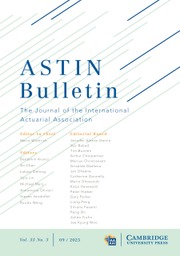No CrossRef data available.
Article contents
Dynamic tonuity: Adapting retirement benefits to a changing environment
Published online by Cambridge University Press: 05 March 2025
Abstract
The tonuity, proposed by Chen et al. ((2019) ASTIN Bulletin: The Journal of the IAA, 49(1), 530.), is a combination of an immediate tontine and a deferred annuity. However, its switching time from tontine to annuity is fixed at the moment the contract is closed, possibly becoming sub-optimal if mortality changes over time. This article introduces an alternative tonuity product, wherein a dynamic switching condition is pivotal, relying on the observable mortality trends within a reference population. The switching from tontine to annuity then occurs automatically once the condition is satisfied. Using data from the Human Mortality Database and UK Continuous Mortality Investigation, we demonstrate that, in a changing environment, where an unforeseen mortality or longevity shock leads to an unexpected increase or decrease in mortality rates, the proposed dynamic tonuity contract can be preferable to the regular tonuity contract.
Information
- Type
- Research Article
- Information
- Copyright
- © The Author(s), 2025. Published by Cambridge University Press on behalf of The International Actuarial Association

